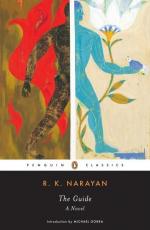|
This section contains 3,716 words (approx. 13 pages at 300 words per page) |

|
SOURCE: "Theme of Art and Immortality in R. K. Narayan's The Guide," in Literary Criterion, Vol. XXV, No. 2, 1990, pp. 36-46.
In the following essay, Singh analyzes the place of art and immortality in Narayan's The Guide.
The desire for immortality which in Jungian terms is a "primordial affirmation" in human beings and which has its "origin in a peculiar feeling of extension in space and time" is realised to the highest degree by a perfect identification and expression of what Jung calls the "collective unconscious." This "collective unconscious," in turn, is realised in its full dimension by its approximation to what F. A. Wilson describes as "the qualitative aspect of the creativity of the universe … the transcendental universe programmed to become aware of itself". Now this becoming of the Universe completely aware of itself is presented in Indian thought as Shiva or Vishnu as representative of "Absolute Consciousness...
|
This section contains 3,716 words (approx. 13 pages at 300 words per page) |

|


